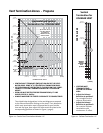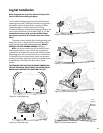
18
Gas Supply Connection
Connect the gas supply line to the stove, before
installing the optional Blower.
If the blower will be installed, use a 45° elbow off the
control valve to create clearance required for the blower
installation.
The gas supply line connection is made to the left side of
the valve. The gas supply line should be 3/8" npt with a
1/2" diameter supply, or the appropriate size to provide
sufficient gas pressure to the valve regardless of the
input setting.
The use of Flexible Gas Appliance Connectors is
acceptable in many areas in the U.S. However, Canadian
methods vary depending on local code.
ALL INSTALLATIONS MUST COMPLY WITH LOCAL
CODE OR IN THE ABSENCE OF LOCAL CODE, MUST
COMPLY WITH THE MOST RECENT EDITION OF THE
NATIONAL FUEL GAS CODE ANSI Z223.1/NFPA 54 OR
CAN-B149.
All codes require a gas shut-off valve (gas cock) and
union, to be installed in the supply line, and in the same
room as the appliance. This allows for the disconnection
of the stove for servicing and maintenance. See fig. 27.
Figure 27. Supply valve coupling.
Pilot Head
Orifice
Retainer
Clip
Pilot Base
Figure 25. Pilot orifice removal and replacement.
14. Remove the Regulator Tower, Gasket, white plastic
disk, and Spring.
15. Install the new regulator: Be sure the new gasket is
properly positioned and tighten screws securely.
16. Install the identification labels to the stove so that they
can be seen by any person that may be servicing the stove.
Label A: apply to back of stove.
Label B: apply to stove’s rating plate.
Small valve Label: apply to valve.
17. Reassemble the stove, apply gas to the system and
check for leaks using a soapy water solution.
18. Adjust the Air Shutter:
CAUTION! USE WORKGLOVES. SURFACES MAY BE HOT!
You will need to adjust the shutter to the position
that supplies the correct amount of air mixture to
achieve the best flame picture with your particular
installation. Start with the shutter stem at the
midway position in the slot in the bottom of the
stove. See fig. 21. Pushing the stem back will restrict
air, while pushing it forward will open the shutter.
Too much air will produce a lighter flame, while too
little will promote long, dark flames and may pro-
mote sooting. Make adjustments in small incre-
ments. With some experimentation, you will find the
shutter position that works best for your installation.
Figure 26. Regulator assembly.
Apply small
label here
Remove black
gasket
Regulator
Tower
NEVER USE AN OPEN FLAME TO CHECK FOR GAS LEAKS.
Correct gas pressure is essential for efficient and safe
operation of this appliance. Correct gas pressure
must be established at the time of installation. For
more details, see the Gas Pressure section of this
manual (page 19).
ALWAYS REFER TO THE LIGHTING INSTRUCTIONS ON THE
INSIDE BACK COVER OF THIS MANUAL WHEN LIGHT-
ING YOUR STOVE.


















